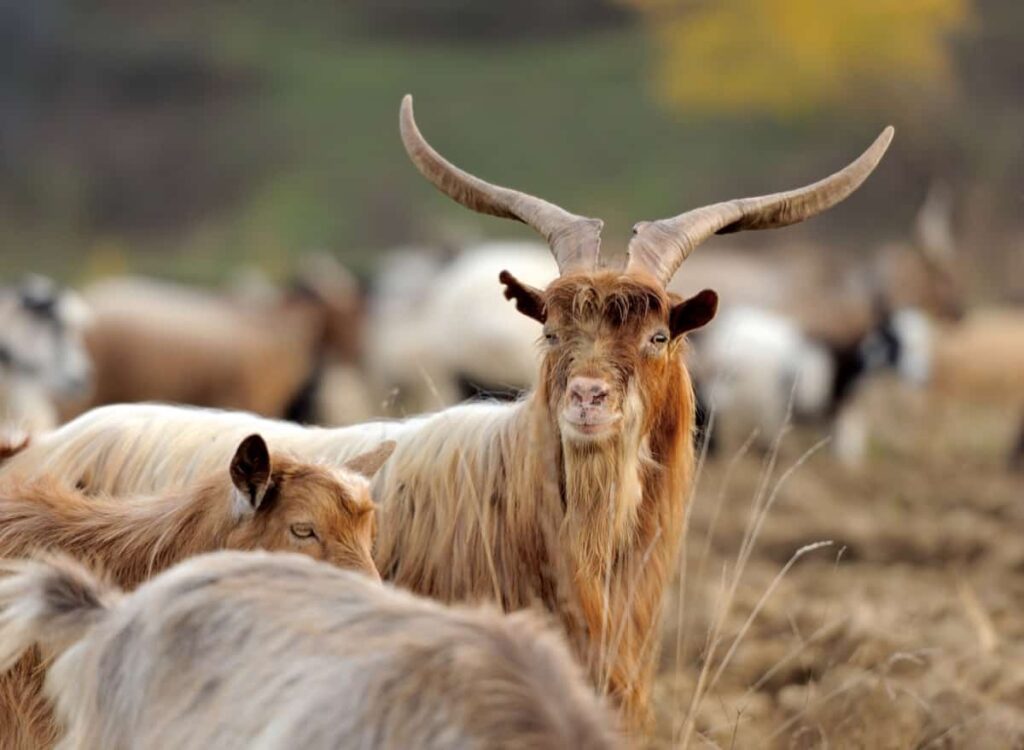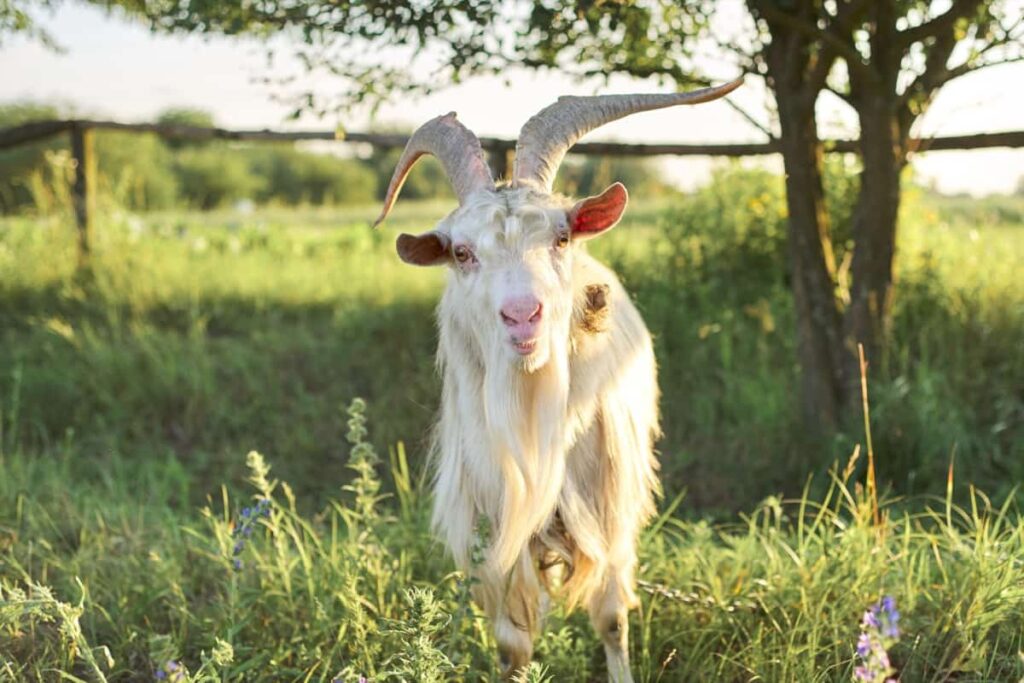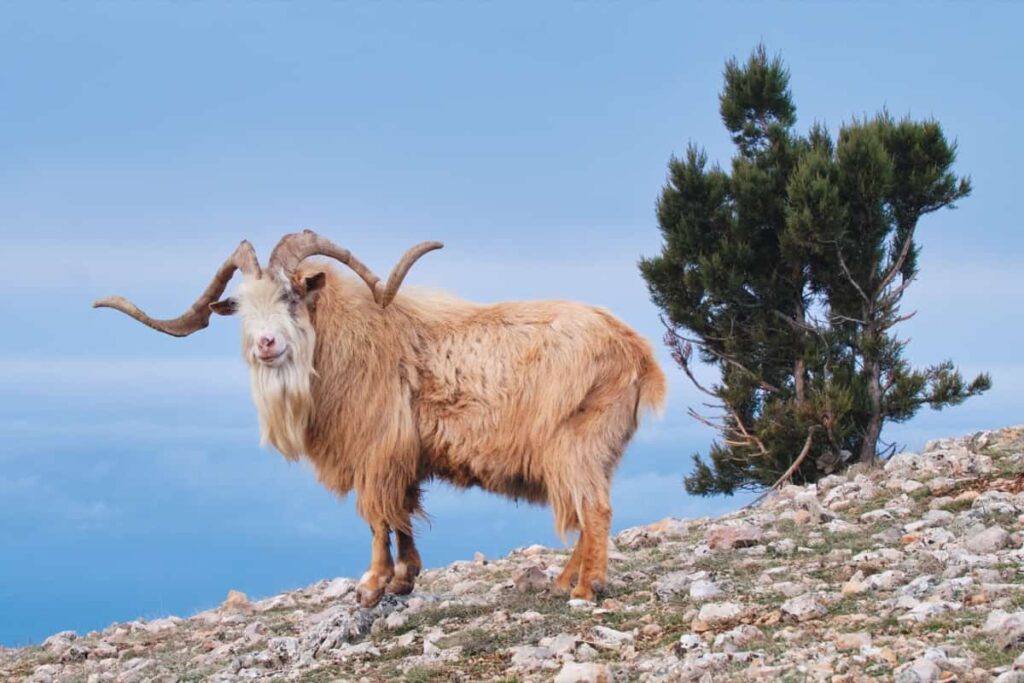The Sarda goat has unique characteristics that make them highly suitable for milk and meat production. Their dual-purpose capabilities make them an ideal choice for farmers.

Characteristics of Sarda Goats
- These goats are known for their adaptability to various climates and terrain types. Sarda goats thrive, whether graze in rocky mountainous regions or lush green pastures.
- One remarkable trait of the Sarda goat is its hardiness. These animals have evolved over centuries to withstand harsh conditions, making them resilient against diseases and parasites. Their strong immune system allows them to resist common ailments that affect other breeds.
- Sarda goats also boast excellent fertility rates. This characteristic makes them ideal for those interested in breeding these animals. Moreover, these goats possess impressive milk production capabilities.
- Sarda goats are highly adaptable animals that can thrive in various climatic conditions. They have excellent foraging abilities and can use marginal grazing lands efficiently.
- Moreover, these goats require relatively low maintenance compared to other breeds. They are hardy animals resistant to common goat diseases and parasites, reducing the need for extensive veterinary care.
Housing Needs for Sarda Goats
- Providing adequate shelter is essential. Sarda goats need a secure and well-ventilated space that protects them from extreme weather conditions such as heavy rain or intense heat.
- The size of the shelter should be spacious enough to accommodate all the goats comfortably, allowing them freedom of movement. It’s important to remember that overcrowding can lead to stress and increase the risk of diseases spreading among the herd.
- In terms of flooring, a clean and dry surface is crucial for good goat health. Concrete floors are commonly used as they are easy to clean and maintain hygiene standards. Additionally, providing bedding material like straw or wood shavings helps keep the goats comfortable and prevents injuries.
- Ensuring proper ventilation within the shelter is vital for preventing respiratory issues in these goats. Good airflow promotes fresh air circulation and reduces humidity levels which can contribute to respiratory problems.
Sarda Goat Profile
| Breed Name | Sarda Goats |
| Weight | Male – 67 kgFemale – 50 kg |
| Height | Male – 77 cm Female – 70 cm |
| Wool color | very variable |
| Use | Milk, also meat |
| Temperament | They are docile and well-mannered goats but can be a bit vary. |
| Breed Size | Medium |
| Horns | Yes |
| Climate Tolerance | All Climates |
| Coat Color | Many |
In case you missed it: Sahelian Goat Facts: Breed Profile, Characteristics

Sarda Goat Weight
- The weight of Sarda goats is an important factor to consider when it comes to their management and potential for productivity. On average, the weight of a male Sarda goat can reach up to 67 kg, while females typically weigh around 50 kg.
- By monitoring the weight of your Sarda goats regularly and providing them with appropriate nutrition and care, you can ensure that they reach their full growth potential. This includes offering a balanced diet of high-quality forage and any necessary supplements a veterinarian recommends.
Feeding Requirements for Sarda Goats
- A well-balanced diet ensures Sarda goats’ optimal health and productivity. These goats are known for their ability to adapt to different environments and thrive on various vegetation types.
- Sarda goats graze on grass and browse on shrubs, leaves, and twigs. Providing them with access to fresh pasture or high-quality hay is essential.
- Water is also vital for these goats’ overall well-being. Clean and fresh water should always be readily available at all times. Ensure they can access water sources within their grazing area or barn.
Requirements for Sarda Goat Farming
- Suitable Climate: Sarda goats are well adapted to Sardinia’s hot and dry climate, so they require a similar environment for successful farming. A warm and arid climate with minimal rainfall is ideal.
- Spacious Grazing Land: These goats are known for their grazing habits, so providing ample grazing land is crucial. The land should have a variety of vegetation to ensure a balanced diet for the goats.
- Good Fencing: Strong fencing is essential to keep the goats safe from predators and prevent them from wandering off. Ensure the fencing is high enough, as these agile animals are skilled jumpers.
- Proper Shelter: Sarda goats can withstand harsh weather conditions but need shelter during extreme temperatures or heavy rainfalls. A well-ventilated barn or shed will suffice.
- Regular Veterinary Care: Like any other livestock, routine veterinary care is necessary to maintain the health of your Sarda goats. This includes vaccinations, deworming, hoof trimming, and periodic health check-ups.
- Clean Water Supply: Access to clean drinking water is crucial for maintaining good health in Sarda goats.
Tips for Raising Healthy Sarda Goats
- These goats require a secure and well-ventilated shelter to protect them from extreme weather conditions and predators.
- Feeding requirements also play a crucial role in their care. Sarda goats are known for being excellent grazers, so providing them with ample access to fresh pasture is essential. Additionally, supplementing their diet with high-quality hay or fodder can help meet their nutritional needs.
- Proper management practices should be implemented in Sarda goat farming. This involves maintaining clean living conditions, practicing good hygiene during milking procedures, and ensuring the overall well-being of the herd.
- Maintaining the health of these goats is crucial for their overall well-being. Regular veterinary check-ups, vaccinations, and deworming treatments are necessary preventive measures.
In case you missed it: Jamunapari Goat Breed: A Comprehensive Information Guide

Common Health Care Tips for Sarda Goats
- Regular Vaccinations: Schedule routine vaccinations for your Sarda goats to protect them from various diseases, including tetanus, pneumonia, and enterotoxemia.
- Proper Nutrition: Provide a balanced diet with high-quality hay or pasture grazing and commercial goat feed. Ensure access to clean water at all times.
- Parasite Control: Implement an effective deworming program to control internal parasites like worms and coccidia. Regular fecal testing can help determine the need for treatment.
- Hoof Care: Trim the hooves regularly to prevent overgrowth and hoof rot. Clean and inspect their hooves regularly for any signs of infection or injury.
- Shelter and Bedding: Provide adequate shelter from extreme weather conditions, ensuring proper ventilation and protection against drafts.
- Hygiene Practices: Maintain cleanliness in their living area by regularly removing manure and soiled bedding. This helps prevent the spread of disease-causing organisms.
Conclusion
The Sarda goat is a breed that has captivated farmers and livestock enthusiasts with its distinct characteristics. This dual-purpose goat is highly valued for its exceptional milk and meat production capabilities. The Sarda goat is a versatile and hardy breed well-suited for milk and meat production. Their adaptability to different climates and high fertility rates make them a valuable addition to any goat farming operation.
Note: The images presented in this post are intended solely for representation purposes. The images are meant to serve as visual aids and should not be relied upon as accurate representations of their real-life counterparts.
- Goat Milking Practices and Equipment: A Beginner’s Guide
- Goat Farming for Fiber: Producing Mohair and Cashmere
- Maximizing Goat Milk Production: Tips for Dairy Goat Farmers
- Goat Farming as a Family Business: Strategies for Success
- Profitable Kenya Goat Breeds for Commercial Dairy and Meat Business
- Unlock the Secrets of Oberhasli Goat: Discover Raising and Management Practices
- Ultimate Guide to Myotonic Goats: Explore Profile to Raising
- Unlock the Secrets of Rove Goat: Discover Management Practices
- Ultimate Guide to Malwa Goat: Explore from Origin to Management Practices